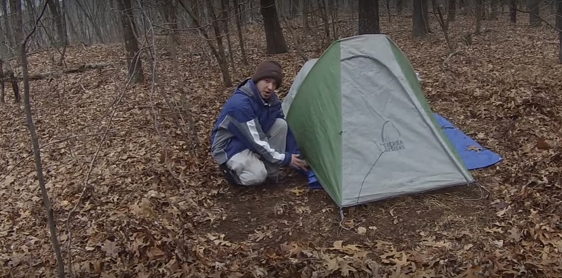Even if you are camping, spending the night outdoors in cold weather can be difficult.
Facing a survival situation in cold weather can be at best inconvenient and at worst deadly, unless you are highly prepared and know what you are doing.
Keeping warm, however, except in extremely cold conditions is easier if you use your surroundings to insulate your tent.
The camper in this situation uses a tarp to separate his tent from the ground and then leaves to insulate the base of his tent, but this method would also work with any insulating substance, including using evergreen bows as a base and insulation and even snow in an emergency situation.
Check out the video on the next page to this amazing way to insulate your tent or shelter using your natural surroundings as the cold and wind repelling insulation you need to stay warm.

Great tip. Will remember this. One idea I had (but haven’t tried yet): tarp on ground, tent, inside tent, moving blankets on floor then sleeping bags, etc. Wanted to rig moving blankets on insides of tent, but haven’t found way to secure the blankets without compromising integrity of tent. Any suggestions?
another trick is to hang a tarp from the trees above, putting that tarp in a position to deflect wind on the sides and rain/snow from above.
Kyle Roe
Jason King
Written instructions? ?
Would this guy blow his damn nose already!! Only made it halfway through and had to stop because I couldn’t stand listening to him sniffing every 3 seconds.
Insulation between you and the ground is very important. Should have left the leaves down.
Lay tarp, add layer of insulation (leaves, bows etc) place tent on top…so that should give you 3 layers, normally tents have a thicker bottom which is good in normal situations. I also add my sleeping pad between my sleeping bag and the tent floor.
Take the time to size the tarp for the tent BEFORE you put the tent down. I’ve found to my chagrin that if it rains or even if the morning dew is heavy and dripping it will drip under the tent floor at the corners the way he put it down. Also, make sure any leaves, etc are only against the faintly … if they are against the tent itself it can compromise the ability of the tent wall to repel moisture.
This video is a horrible suggestion to a “survival” possibility! This would not save you! If you do not have gear to withstand the elements, anyone who does this would not make it. There are so many other things you could do with what he has around him to “better” your odds! This would change what? 1 ° ? At the absolute very worst he could have folded the tarp over, in half, then set the tent on top…. This is honestly a very poor choice for a “survival” situation….
Good tip. I always used a trick Ron Hood taught and that is to fill two large lawn bags with leaves or pine needles and use that as insulation. I lay my sleeping bag on that and it keeps me warm all night. I’m trying to figure out a way to keep from losing so much heat through the dome of the tent. Just short of covering the whole thing in duff I can’t seem to figure anything else. Lol
Rule of thumb is that you need to be off the ground with at least 4″ of insulation when compressed. His idea is good to block drafts. He also said he has a really good sleeping system, so I’m guessing he means his bag setup is a polar one of some type.
Iv done something similar to this but I filled the tarp with leaves, folded it over and put the tent on top of that then stuff leaves in between the screen and rain cover
If you suspect rain do not lay tarp where will run under tent! Putting pointed objects toward your tent might not be a good idea either. Ray Drozd’s suggestion about leaves is better than clearing the ground.
Cover with leaves or snow after erected to help insulate it, but don’t weigh it down and leave breathing ventilation.